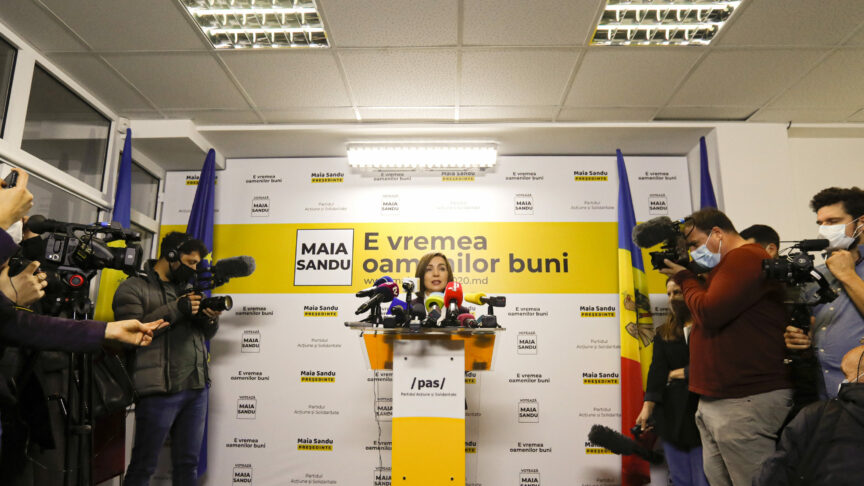Separate ways: Contrasting elections in Georgia and Moldova
Recent elections have seen Georgia’s ruling party dig in, while Moldova’s has lost the presidency
The recent elections in Georgia and Moldova have produced very different results. In Georgia’s parliamentary election, held on 31 October, the ruling Georgian Dream won 48.2 per cent of the vote and 14 out of 30 constituency seats, giving it 75 out of 150 parliamentary seats. And it was also expected to win most of the remaining 14 seats to be decided in run-offs on 21 November. The United National Movement (UNM), founded in 2001 by Mikheil Saakashvili, came in second, with 27.2 per cent and 34 seats. Seven smaller parties won 22 seats.
But all opposition parties have cried foul and refused to take up their positions in the new parliament. Many observers predicted before the vote that election fraud in Georgia would be buried in social networks and in the provinces, rather than being as open and egregious as it was in Belarus’s recent presidential election. So it proved. But most opposition parties claimed that adding up all the instances of ballot stuffing, ‘carousels’ (organised repeat voting with pre-marked ballots), ‘controlled voters’, and other fraud amounted to 3-4 per cent of the vote – though some went as high as 7-8 per cent. Fifty-three per cent of the vote in Georgia’s 30 majoritarian constituencies was allegedly tainted. However, the OSCE Parliamentary Assembly’s preliminary report was more cautious, declaring that “fundamental freedoms [were] respected in competitive … elections”, although “pervasive allegations of pressure on voters and blurring of the line between the ruling party and the state reduced public confidence in some aspects of the process”. Local observers found no evidence of mass fraud, but considered the elections to be “worse” than those in 2016.
Georgian Dream has been in office since 2012, and is deeply entrenched in the state apparatus. But the opposition UNM still sees the party as a usurper, claiming credit for shaping modern Georgia in its own image during Saakashvili’s decade as president. The UNM may not be able to say that it actually won, but it argues that fraud gave Georgian Dream what is likely to be an absolute majority. As a result, the country is in another political crisis, one involving mass demonstrations similar to those in 2019. The authorities have used water cannons against protestors, and are likely to engage in other shows of strength after the run-offs. Clearly, the deal to change the electoral system that the European Union and the United States brokered in March 2020 has not taken the deep-rooted antagonism out of Georgian politics.
Moldova’s presidential election, in contrast, resembled the 2016 vote: Maia Sandu, leader of the pro-European Party of Action and Solidarity, once again faced Igor Dodon, the incumbent and the head of the Russian-backed Socialist Party. After Sandu and Dodon governed together in an experimental coalition from June to November 2019, the Socialists formed an uneasy coalition with the Democratic Party – which is closely associated with exiled oligarch Vladimir Plahotniuc. There were signs that the coalition was fraying before the November election. And the Socialists did not control all key institutions of state in the same manner as Georgian Dream. The Central Electoral Commission made independent rulings, and the Ministry of Foreign Affairs did its best to allow free and fair voting at 139 polling stations abroad.
Georgian Dream has been in office since 2012, and is deeply entrenched in the state apparatus. But the opposition UNM still sees the party as a usurper
As the incumbent president, Dodon lost popularity because Moldova was hit hard by the coronavirus, and the government lacked the resources to provide business or income support. Late in the campaign, he abandoned his moderate appeal to centrist voters and repeated the anti-Sandu smear tactics he used in 2016, alienating the supporters of the third- and fourth-placed candidates, who collectively accounted for 23.4 per cent of the vote.
Sandu built a lead in the first round of the election on 1 November with 36.2 per cent to 32.6 per cent, before winning comfortably in the run-off two weeks later, with 57.7 per cent to Dodon’s 42.3 per cent. The key to her large margin of victory was her strong lead – 92.9 per cent to 7 per cent – among the 262,000 Moldovans voting abroad, who accounted for a record 16 per cent of the total vote. But Sandu still won the support of 51 per cent of those who voted in Moldova. Conversely, only 14,000 people from Transnistria voted in round one, and 31,000 in round two – 85.8 per cent of them for Dodon. By comparison, this figure was 37,000 in the 2019 parliamentary election. The Socialists hoped that as many as 70,000 would do so this year. However, the Central Electoral Commission ruled against bussing in voters from Transnistria en masse, stating that a maximum of eight people could travel together to vote.
At first, Dodon acted similarly to US President Donald Trump: he was reluctant to concede and made dark hints that the courts had to verify the outcome of the vote. But, due to the size of Sandu’s victory, this did not last for long. And it seems unlikely that there will be post-election protests in support of Dodon. Even Russian President Vladimir Putin congratulated Sandu.
With parliament more powerful than the president, Moldova seems certain to hold an early parliamentary election. The pendulum in Moldova may swing towards a new political era, but that in Georgia looks firmly stuck.
The European Council on Foreign Relations does not take collective positions. ECFR publications only represent the views of their individual authors.
